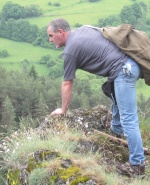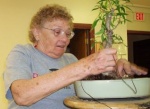fertilizer
+8
Norma
tim stubbs
Ka Pabling
bonsaisr
Harleyrider
JimLewis
DaveP
littlebobby
12 posters
Page 1 of 1
 fertilizer
fertilizer
Pellet or liquid? What's the difference? I've been using organic chicken poop, but my charming dog eats it if she can get her paw on it. One or two of my trees are within the reach of her voracious jaws. was thinking of getting some liquid stuff for those trees.
The trees I've got planted - is normal 'tree and shrub' food suitable (including my monster blackthorne in the training box) ?
The trees I've got planted - is normal 'tree and shrub' food suitable (including my monster blackthorne in the training box) ?

littlebobby- Member
 Re: fertilizer
Re: fertilizer
I use both organic cakes ("pellets") and liquid. Both are fairly well balanced (N,P, and K numbers being close together rather than skewed to one end). The primary reason for using both is to ensure good coverage of micronutrients. The organic cakes also give the benefit of providing a small amount of feed with every watering.
Selecting a proper fertilizer boils down to a couple things: a) the time of year, b) type of fertilizer, and c) the stage of the tree.
Time of Year:
In spring and summer, a balanced fertilizer covers all the plant's needs - nitrogen (the N number) for good foliage health, phosphorus (the P number) for good root development - although this was previously thought to be based off the potassium content, and potassium (the K number) for bud, flower, fruit/seed, and a lesser degree, roots. In the fall, the plant is working hard to store as much energy as possible in the roots for the coming dormancy period, so it has little use for nitrogen. Switching to a fertilizer skewed to have a small nitrogen number and higher phosphorus & potassium numbers helps the tree prepare.
Type of Fertilizer:
Stay away from food typically used on annuals or houseplants. The nitrogen source tends to be urea-based and the fungus responsible for root rot benefits from urea. When in doubt, read the label. If you already have some, use this earlier in the year and use it sparingly. Since our soils tend to hold very little nutrients, this will give plenty of time in the late summer and fall for any residual urea to be flushed from the soil rather than holding it over the winter, when root rot tends to be more of a problem. Stay away from most slow-release types. Products like Osmocote are good for landscape (lots of soil area) and houseplants (constant temperature), but tend to be a disaster in bonsai containers. These products break down in the presence of heat. The more heat, the faster they break down and release fertilizer. The middle of summer is not when you want to be dumping high doses of fertilizer at an uncontrolled rate into your tree's soil. More often than not, you'll end up with burned roots, burned foliage, and a tree trying to recover in fall when it really should be preparing for the upcoming dormancy.
Stage of Tree:
When you've got a tree that's transitioned from development to maintenance, where you're focused on maintaining small leaves/needles, fine ramification, etc., throwing heavy doses of fertilizer at it won't help anything. The tree will grow faster and more coarsely, tending to ruin the fine details. The fertilizer is still needed for overall health, just don't heap it on.
Fertilizer Supplements:
If you search around, you'll find some anecdotal evidence regarding the use of Humic Acid, which can be quite beneficial. Al Keppler has written much about it and I've been using it for the past several years with notable and clear results. Other supplements can be helpful depending on what you're trying to achieve. These include Fluvic Acid and various endo/ectomychorriza cocktails. (while pines rely heavily on these, all trees can benefit assuming they get the right one.
Hope that sheds a little light.
Kindest~
-d
Selecting a proper fertilizer boils down to a couple things: a) the time of year, b) type of fertilizer, and c) the stage of the tree.
Time of Year:
In spring and summer, a balanced fertilizer covers all the plant's needs - nitrogen (the N number) for good foliage health, phosphorus (the P number) for good root development - although this was previously thought to be based off the potassium content, and potassium (the K number) for bud, flower, fruit/seed, and a lesser degree, roots. In the fall, the plant is working hard to store as much energy as possible in the roots for the coming dormancy period, so it has little use for nitrogen. Switching to a fertilizer skewed to have a small nitrogen number and higher phosphorus & potassium numbers helps the tree prepare.
Type of Fertilizer:
Stay away from food typically used on annuals or houseplants. The nitrogen source tends to be urea-based and the fungus responsible for root rot benefits from urea. When in doubt, read the label. If you already have some, use this earlier in the year and use it sparingly. Since our soils tend to hold very little nutrients, this will give plenty of time in the late summer and fall for any residual urea to be flushed from the soil rather than holding it over the winter, when root rot tends to be more of a problem. Stay away from most slow-release types. Products like Osmocote are good for landscape (lots of soil area) and houseplants (constant temperature), but tend to be a disaster in bonsai containers. These products break down in the presence of heat. The more heat, the faster they break down and release fertilizer. The middle of summer is not when you want to be dumping high doses of fertilizer at an uncontrolled rate into your tree's soil. More often than not, you'll end up with burned roots, burned foliage, and a tree trying to recover in fall when it really should be preparing for the upcoming dormancy.
Stage of Tree:
When you've got a tree that's transitioned from development to maintenance, where you're focused on maintaining small leaves/needles, fine ramification, etc., throwing heavy doses of fertilizer at it won't help anything. The tree will grow faster and more coarsely, tending to ruin the fine details. The fertilizer is still needed for overall health, just don't heap it on.
Fertilizer Supplements:
If you search around, you'll find some anecdotal evidence regarding the use of Humic Acid, which can be quite beneficial. Al Keppler has written much about it and I've been using it for the past several years with notable and clear results. Other supplements can be helpful depending on what you're trying to achieve. These include Fluvic Acid and various endo/ectomychorriza cocktails. (while pines rely heavily on these, all trees can benefit assuming they get the right one.
Hope that sheds a little light.
Kindest~
-d
DaveP- Member
 Re: fertilizer
Re: fertilizer
Well, I think a lot of useless thought goes into fertilizing bonsai. Your trees need NPK. They need NPK 12 months out of the year, no matter what people think. They use what they need, and we water so frequently that the rest simply washes away through the drainage holes. They do NOT care what form they get it in.
All this stuff about lower N in the fall is mostly blather. Ma nature actually increases N in the fall and winter with all the leaves that fall on the ground and rot. Trees will slow down in the fall and winter, so it makes sense to slow the fertilizer, too -- because you save money. But even if you kept on fertilizing weekly, the excess would simply wash away.
As for trace elements, MOST organic fertilizers are deficient in trace elements (micronutrients). Home make poo balls almost certainly are. You'd have to read the fertilizer label (if buying them in the USA they MUST have a label) to see what commercial organic fert contains. But the most widely available fish emulsion or seaweed contain none.
There's enough work involved in bonsai that you don't need to invent more by complicating fertilization.
All this stuff about lower N in the fall is mostly blather. Ma nature actually increases N in the fall and winter with all the leaves that fall on the ground and rot. Trees will slow down in the fall and winter, so it makes sense to slow the fertilizer, too -- because you save money. But even if you kept on fertilizing weekly, the excess would simply wash away.
As for trace elements, MOST organic fertilizers are deficient in trace elements (micronutrients). Home make poo balls almost certainly are. You'd have to read the fertilizer label (if buying them in the USA they MUST have a label) to see what commercial organic fert contains. But the most widely available fish emulsion or seaweed contain none.
There's enough work involved in bonsai that you don't need to invent more by complicating fertilization.

JimLewis- Member
 Re: fertilizer
Re: fertilizer
I use a combination of chicken sh*te pellets, sprayed on seaweed extract, and I've just picked up a bottle of liquid, the latter mainly as stated to stop the dog from eating the former.

littlebobby- Member
 Re: fertilizer
Re: fertilizer
I heard somewhere that chicken manure clogs the soil/fine roots/drainage holes. Then again, I'm a novice, so what do I know.

Harleyrider- Member
 Fertilizer
Fertilizer
Read Brent Walston's article at Evergreen Garden Works. That says it all.
Iris
Iris

bonsaisr- Member
 Re. Fertilizers
Re. Fertilizers
I agree with you Jim, theres so much work in bonsai that we should try to simplify things. I used to get lots of advice on what fertilizer to use and I got more confused., now I use 14 14 14 in small doses weekly and got better results. I am not worried of overdose because I use river sand which drains well.

Ka Pabling- Member
 Re: fertilizer
Re: fertilizer
If you want some decent advice you can do no better than read what Walter Pall said on
http://walter-pall-bonsai.blogspot.com/2009/06/feeding-again.html
Ive followed this and my trees have improved no end
http://walter-pall-bonsai.blogspot.com/2009/06/feeding-again.html
Ive followed this and my trees have improved no end

tim stubbs- Member
 Re: fertilizer
Re: fertilizer
Thanks for the link to Walter Pall's blog , Tim. I believe his methods are good and I'm happy to see him point out that a houseplant can be fertilized with the same product as bonsai but to different degrees.
I do have a question, Walter speaks about "modern substrate" ... Soil components? What exactly does he mean? Could you give more detail?
Best regards,
Norma
I do have a question, Walter speaks about "modern substrate" ... Soil components? What exactly does he mean? Could you give more detail?
Best regards,
Norma

Norma- Member
 Re: fertilizer
Re: fertilizer
Norma ,
about substrate , Walter posted the following (it is German But is easily translated )
http://walter-pall-bonsai.blogspot.com/2009/04/about-substrate-watering-and-feeding-in.html
tim
about substrate , Walter posted the following (it is German But is easily translated )
http://walter-pall-bonsai.blogspot.com/2009/04/about-substrate-watering-and-feeding-in.html
tim

tim stubbs- Member
 Re: fertilizer
Re: fertilizer
Sorry Tim, I don't know how to translate Walter's German. Actually "computerese" is a foreign language ...!!
Help anyone?
Norma
Help anyone?
Norma

Norma- Member
 Re: fertilizer
Re: fertilizer
try http://babel.altavista.com/tr
then paste the link into the translate web page box and select the language
tim
then paste the link into the translate web page box and select the language
tim

tim stubbs- Member
 Re: fertilizer
Re: fertilizer
Hi Tim, I went through your simple steps but  I had an "error" so they say! Typical ... so .... can you make it simple? What is modern substrate?
I had an "error" so they say! Typical ... so .... can you make it simple? What is modern substrate?
Thanks,
Norma
Thanks,
Norma

Norma- Member
 Re: fertilizer
Re: fertilizer
Norma ,
Substrate: a roughly equal size grains must absorb water and dispensing, WITHOUT EARTH must be used, must not crumble easily, should be inexpensive, in the dry state should be easy, so you can wear big trees.
Since, therefore, be considered: Lavasplit, pumice, expanded clay, zeolite, Chabasai, Boncoco, hard Akadama, Styrofoam crumbs (no joke), and a few other, you may find yourself if you understand the principle.
Normal academic is only partially useful, because it crumbles, especially frost and then a very dangerous Lehmbatzen forms.
Not usable: any soil, compost soil, stone, gravel, sand, etc.
Of course, a tree growing in the sand and potting soil, but that's just not oprtimal.
All genananten substrates can be alone or as mixed use. All one can safely after Umtopfen reuse.
There are endless' IDEAL SUBSTRATES '. I think THAT IS NO MATTER WHAT IS DA MAN AND IN ANY COMPOUND
does that help
tim
Substrate: a roughly equal size grains must absorb water and dispensing, WITHOUT EARTH must be used, must not crumble easily, should be inexpensive, in the dry state should be easy, so you can wear big trees.
Since, therefore, be considered: Lavasplit, pumice, expanded clay, zeolite, Chabasai, Boncoco, hard Akadama, Styrofoam crumbs (no joke), and a few other, you may find yourself if you understand the principle.
Normal academic is only partially useful, because it crumbles, especially frost and then a very dangerous Lehmbatzen forms.
Not usable: any soil, compost soil, stone, gravel, sand, etc.
Of course, a tree growing in the sand and potting soil, but that's just not oprtimal.
All genananten substrates can be alone or as mixed use. All one can safely after Umtopfen reuse.
There are endless' IDEAL SUBSTRATES '. I think THAT IS NO MATTER WHAT IS DA MAN AND IN ANY COMPOUND
does that help
tim

tim stubbs- Member
 Re: fertilizer
Re: fertilizer
Hello everybody
May I translate this as it is meant by Walter.
Best regards
Martin
May I translate this as it is meant by Walter.
There are countless "IDEAL SUBSTRATES". You can use anything as long as it fulfills these requirements.There are endless' IDEAL SUBSTRATES '. I think THAT IS NO MATTER WHAT IS DA MAN AND IN ANY COMPOUND
Best regards
Martin

Klaudia & Martin- Member
 Re: fertilizer
Re: fertilizer
I'm trying the organic fertilizer route. I have been using blood and bone meal. But what is an organic source of Potassium?
Libby
Libby
bumblebee- Member
 Re: fertilizer
Re: fertilizer
bumblebee wrote:I'm trying the organic fertilizer route. I have been using blood and bone meal. But what is an organic source of Potassium?
Libby
Should be some K in blood meal, but check here:
potassium sources

John Quinn- Member
 Re: fertilizer
Re: fertilizer
Another thing to remember about soils, use the proper size particle. Smaller particles will help retain more moisture then larger particles. I use around an 1/8 inch particle of "haydite"/Lava/pumice in some combination (usually thirds but it matters little). I have had no watering issues this season in 100+ degree heat. One other thing Walter mentions is his use of a little rough peat. This is an important thing to include for acidity as he mentions, especially in this type of soil in warmer climates.
I use a cottonseed meal cake with a little seaweed in there (very easy, not too messy and does not smell). Trees do terrific with it. I supplement weekly with fish emulsion with a scoop of miracle grow thrown in for the micronutrients. Here is where the peat is important, from my own practical experience.
I removed the cakes, did not replace and opted to simply use the miracle grow 1x week. It got very hot and my watering increased. I soon developed chlorosis in just the maples I opted to not replace cakes on. It was not immediate but took a few of weeks. I tried a couple of applications of chelated iron. Nothing improved. I went out on a limb and scratched some peat into the soil on one tree. Boom, it greened up.
The cottonseed in the cakes was supplying many things (micronutrients, macronutrients) but in this case it was also supplying necessary acidity to allow the plant to take up nutrients (or for the soil to free up the nutrients). So, I scratched some cottoneseed meal into the soil of the others and they're greeening up quickly. Aside from a steady release of nutrients over time, cottonseed meal will provide microbes and help lower ph of soil.
[u]
I use a cottonseed meal cake with a little seaweed in there (very easy, not too messy and does not smell). Trees do terrific with it. I supplement weekly with fish emulsion with a scoop of miracle grow thrown in for the micronutrients. Here is where the peat is important, from my own practical experience.
I removed the cakes, did not replace and opted to simply use the miracle grow 1x week. It got very hot and my watering increased. I soon developed chlorosis in just the maples I opted to not replace cakes on. It was not immediate but took a few of weeks. I tried a couple of applications of chelated iron. Nothing improved. I went out on a limb and scratched some peat into the soil on one tree. Boom, it greened up.
The cottonseed in the cakes was supplying many things (micronutrients, macronutrients) but in this case it was also supplying necessary acidity to allow the plant to take up nutrients (or for the soil to free up the nutrients). So, I scratched some cottoneseed meal into the soil of the others and they're greeening up quickly. Aside from a steady release of nutrients over time, cottonseed meal will provide microbes and help lower ph of soil.
[u]
Last edited by NeilDellinger on Wed Aug 05, 2009 11:38 am; edited 1 time in total (Reason for editing : omitted word)
NeilDellinger- Member
 Similar topics
Similar topics» What fertilizer should I use?
» Watering a baobab tree
» fertilizer
» Too Much Fertilizer?
» bonsai fertilizer
» Watering a baobab tree
» fertilizer
» Too Much Fertilizer?
» bonsai fertilizer
Page 1 of 1
Permissions in this forum:
You cannot reply to topics in this forum






